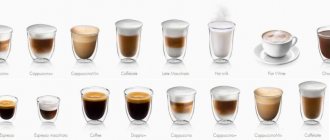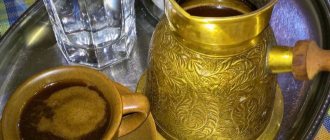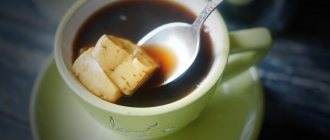Author: Ordog
July 13, 2015 07:23
Tags: food coffee recipes
22196
16
Hot water and coffee are only part of the magic. Believe it or not, coffee is brewed very differently in different countries around the world. Good morning everyone!
0
See all photos in the gallery
Viennese, Turkish, Americano: how coffee is prepared and drunk in different countries of the world
Ethiopia and Yemen are considered the birthplace of coffee. The world's first coffee plantation appeared in Yemen. According to one of the popular versions, the name of coffee comes from the Arabic “qahwa”, “dispelling sleep”.
Yemen still grows coffee for export, but Yemenis themselves hardly drink it, definitely preferring tea. The coffee culture has been lost there. But thanks to the Turks, this culture spread to many other countries. And everywhere coffee is brewed and drunk differently.
Türkiye
Photo: Getty Images
The Turkish method of making coffee appeared in the middle of the 16th century and has remained virtually unchanged since then. Ground coffee is poured with water and boiled in a copper cezve over a fire or hot sand. Then it is poured into small porcelain glasses “filjan”. Cups are often placed in a metal cup holder with a handle for convenience. In a more modern version, coffee is served in ordinary small cups, and they are preheated. A sugar bowl with lump sugar, often sweets, as well as a glass of cold water, which is supposed to be washed down with coffee, are placed separately on the table. Cold water creates a taste and temperature contrast, and also allows you to “cleanse” your taste buds.
Photo: Getty Images
Naturally, coffee with grounds at the bottom cannot be drunk in one sip, like espresso; it is drunk slowly, savoring every sip. When the cup is empty, you can cover it with a saucer, turn it over and tell fortunes on the coffee grounds. Usually this is done by a falcı (fortune teller), but you can simply download the corresponding application to your phone (for example, Falcı Füsun) and guess yourself.
Photo: Getty Images
Turks drink coffee after meals and throughout the day, but not at breakfast - they usually prefer tea in the morning.
In addition to classic Turkish coffee, the American way of drinking “take-and-go” coffee in cardboard glasses and instant coffee with various additives are quite common in big cities.
Austria
Photo: Getty Images
Everyone has heard the legend about the Polish officer Jerzy-Frantiszek Kolszycki, a native of Sambir, who served in the Austrian army and, due to his awareness of the Turkish coffee culture, became the first to correctly estimate the value of the bags of coffee abandoned by the Turks during the retreat from Vienna in 1683. Most likely , Kolshitsky was not the first owner of a coffee shop in Austria and certainly not the first in Europe. However, it is quite possible that it was he who stood at the origins of the Viennese coffee culture, which is characterized by various varieties of coffee with milk and cream, and, most importantly, in the company of dessert. And not so much with croissants, but with pastries and cakes, for which Austrian confectioners are famous all over the world - apple strudel and Sacher cake immediately come to mind. One of the most famous confectionery shops is Demel (see photo above).
In the old days, coffee was ordered by color. The guest chose the desired shade using the Farbskala (color scale) and ordered the corresponding number. In a modern Austrian coffee shop, visitors most often order “Schwarzer” (essentially espresso, but a little more water), Kleiner Brauner - espresso with milk, melange - coffee with milk and foamed milk (essentially the same as cappuccino). Melange is sometimes topped with whipped cream and is almost always served with a glass of water.
Photo: Getty Images
A special version of melange is imperial melange (Kaisermelange), to which, in addition to milk and milk foam, egg yolk, sugar (honey) and cognac are added. We call this option “Viennese coffee”. Also worth trying in Austria is Biedermeier coffee - double espresso with apricot liqueur and cream.
Italy
Italians are perhaps the most coffee-drinking nation in Europe, if you exclude Turkey. Like the Turks, the Italians have created their own unique coffee culture. The first coffee houses arose in the city-republic of Venice back in the 16th century, from there coffee gradually spread throughout the north of Italy and further to the south.
Photo: Getty Images
In 1933, the Bialetti company invented and released the “moka” geyser coffee maker - a symbol of Italian coffee culture. Just twenty years ago, coffee in moka was brewed in every Italian home every day. Then espresso machines became cheaper and became ubiquitous, but moka coffee is still a common thing for Italians.
Matteo Renzi, previous Prime Minister of Italy. Getty Images
The drink from a geyser coffee maker differs from espresso in lower strength, since in the machine the steam passes through the ground coffee under greater pressure and extracts more caffeine. For this reason, a single espresso in Italy takes up about a quarter of the volume of a coffee cup - if you drink a whole cup of coffee of this strength, it will be too much even for a coffee maniac. If the morning is not going well at all, an Italian will ask for a double espresso (doppio espresso) at the bar.
Other popular options are cappuccino or espresso with milk (caffe latte), and the milk can be cold (freddo) or hot (caldo). If you just ask for a “latte,” the bartender will be very surprised and put a glass of milk in front of you.
According to an unshakable tradition, cappuccino is drunk only in the morning (before 11-12 o'clock), and never after meals, since Italians firmly believe that milk complicates the process of digesting food and is hard on the stomach. But espresso after or instead of food is just right. A typical breakfast is espresso or cappuccino with a bagel (cornetto).
Photo: Getty Images
In small towns, locals come to the bar in the morning not only for coffee, but also for a pleasant chat with the bartender and friends, so it is customary to sit at a table there. In large cities, the morning ritual is completely different and also absolutely unique: before the opening of offices in bars there is a queue, there is nowhere to sit down and there is no time, so espresso is drunk while standing, and often bartenders, when there is an influx of people, put the cups on the counter ahead of time, clients immediately snatch them up and often they pass it on to each other, like in Ukraine - a ticket on a bus.
Fun detail: many Italians have their own unique taste preferences and therefore order not just “espresso with hot milk,” but “hot, but not too hot,” or “cappuccino, but less coffee,” etc.
France
Coffee culture was imported here from Italy: Sicilian Francesco Procoppio opened a coffee shop opposite the Comedie Francaise theater in 1672. Therefore, in general, the French have adopted the Italian way of preparing and drinking coffee, but with some noticeable differences. In particular, few people here have mocha at home, and it is not customary to drink espresso while standing, as in Italy - the French, like most other nations, prefer to spend time drinking a cup of coffee while sitting at a table, while reading a newspaper or watching passers-by. According to statistics, 85% of French people drink coffee daily; in recent years, many have acquired a Nespresso coffee machine at home.
Two popular types of coffee in a cafe or restaurant are espresso (which adds more water than Italian) and cafe allonge - “long coffee”, a cross between espresso and Americano. Espresso with milk is called noisette (from the French “nut”, but not because of the taste, but because of the color). Cafe au lait is essentially an Americano with milk.
Northern Europe
Oddly enough, it is the Finns, Swedes and Dutch who consume the most coffee per capita (see illustration). This is explained by the fact that in Northern European countries coffee is prepared and drunk in the American style - in offices, from large glass coffee pots. This drink contains quite a lot of caffeine and has dubious taste qualities from the point of view of adherents of traditional coffee culture. But it allows you not to hibernate during the long northern winter.
USA
The United States is the largest consumer of coffee in the world, but the drink is viewed very differently there than in Southern Europe. The descendants of immigrants from Britain drank coffee like tea in large mugs, and the quality of this drink was very low. In fact, good coffee is still rare in the USA. This is where the culture of takeaway coffee arose, in large paper cups, which is drunk like soda or tea, often on the go. Back in the 40s of the last century, coffee machines appeared in the USA, where coffee was bought “on tap” (in the USSR there were also such machines, but later, in the 70s).
Photo: Getty Images
In 1971, a store selling freshly roasted coffee opened in Seattle, which later became a coffee shop, and now Starbucks is the world's largest coffee chain, successfully popularizing modern American coffee culture. Starbucks' coffee quality and selection are incomparably better than any of its US predecessors, but typical cup sizes and on-the-go consumption patterns have not changed.
Photo: Getty Images
Nowadays, personal reusable mugs and glasses are becoming increasingly popular, instead of disposable ones, which litter the environment.
Istanbul, Türkiye
Despite the fact that Istanbul has been a coffee city since the times of the Ottoman Empire, now most of its residents still prefer tea. However, you can drink a cup of excellent coffee, most often brewed on sand, in almost any city. But do try the herbal tea here: it has an amazing taste and subsequently gives a relaxing effect, which is surprising since the caffeine level in it is quite high.
Vienna, Austria
The Habsburg Empire is associated with the history of the coffee bean. Throughout this luxurious era, since the early 1700s, the first kaffehäusers appeared in the city, who initially worked only for high society. Many of them have survived to this day, only now such simple joys are available to everyone.
Italy
Article on the topic
Curry, sausages and pizza. What do they order at home in other countries? They serve a magnificent ristreto, which is always accompanied by chocolate.
In Milan, coffee is drunk slowly from large, thick-walled cups. Nothing can disrupt coffee drinking, even if it happens in the middle of the working day. But in the south of Italy it is not customary to sit for a long time over a cup of coffee. Espresso is popular here; Italians sit at the bar, order coffee, and finish it in three sips.
Italians drink tea, but rarely and not very willingly, not particularly understanding the varieties and methods of brewing it.
Greek varis glycos
Another country with centuries-old coffee traditions is Greece. In Ukraine, in order to ward off an unwanted groom, you need to roll him a watermelon; in Greece, you just need to pour coffee. No foam.
The Greeks are very sensitive to coffee foam. For them, this is a sign of respect and reverence, so dear guests are always served coffee with thick, fluffy foam.
At the same time, residents of Hellas prefer highly roasted, finely ground coffee. The preparation method is somewhat reminiscent of the Turkish one, but the Greeks drink rather sweet coffee.
The sweetest version of Greek coffee is varis glikos. To cook it, you will need:
- 100 ml water (for two servings);
- 1 dessert spoon of finely ground coffee;
- 2 dessert spoons of sugar.
As already mentioned, the Greeks brew coffee in the same way as the Turks. But there are several nuances.
In order for the foam to form thicker and faster, the drink must be stirred constantly. In addition, this will help the sugar dissolve faster.
To enhance the foamy effect, you can slightly raise the Turk above the heat during cooking.
After the final NOT bringing to a boil, remove the coffee from the heat and leave it in the Turk (briki in Greek) for a minute or two.
Pour the coffee in portions so that each cup contains as much foam as possible.
Danish coffee
Only Scandinavians drink more coffee than Italians.
A striking example of this is the Danes. They drain their coffee cups at least 5 times a day: at breakfast, lunch, afternoon snack (at three o’clock), dinner and before bed. And the residents of this harsh little state carry a thermos with them all the time. Guess what's in it? Of course! You can't warm yourself with vodka.
There is even an area in Copenhagen that locals call the “Latte District”. The "Latte District" gets its name from the concentration of coffee shops per square meter.
The prices in these establishments, however, are a little steep, so the Danes prefer to sip coffee at home. They drink everything from regular espresso to exquisite “Irish” coffee with whiskey and whipped cream.
But perhaps the most Danish of all recipes is coffee with cloves and cinnamon. To prepare it you will need:
- 500 ml freshly brewed black coffee;
- 100 ml dark rum;
- 20 grams of brown sugar;
- 2 cinnamon sticks;
- “stars” of cloves;
- marshmallows
Use medium-ground, low-roast coffee. Brew the drink as usual (you can use a drip coffee maker or French press).
The process of making Danish coffee is similar to brewing mulled wine. Pour the brewed coffee into a small saucepan. Add rum, sugar and spices. Stir and let it brew for a while. Then place the saucepan on low heat.
Bring to a boil and immediately remove from heat. Let the coffee sit for 60-80 minutes and allow it to absorb the aroma and flavor of the cinnamon and cloves. Then you can reheat the drink and serve, pouring it into large, deep glasses. They drink this coffee with marshmallows or cookies.
Malaysia
Traditional coffee in this country is called yuanyang. And, in fact, it is conditionally considered coffee, because it also includes tea - a special one, prepared from black tea leaves poured with boiling milk. Two parts of this drink are mixed with one part of espresso and the resulting blend is drunk hot or chilled, depending on the weather.











